In Manali, I visited the Hadimba temple. This temple is dedicated to the demoness from the Mahabharata. She Bheema marries and later gives birth to his son Gatothkacha.
The ride to Leh
The ride from Manali to Leh goes through multiple valleys in the Himalayas and one gets to see 4 mountain passes (Rohtang, Baralachala and Taglangla are the three I remember), atleast 2 (Chenab & Beas) of the 5 rivers that goes through Punjab, 3 high altitude lakes (Surajtal, Chandratal, Deepaktal).
Taglangla  | Surajtal  |
Deepaktal 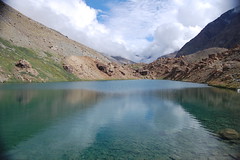 |
The ride in a shared taxi will cost each person about Rs. 1200. It goes through the beautiful Kullu & Lahaul valleys in HP before entering Jammu & Kashmir.
The change in the terrain & the vegetation is clearly
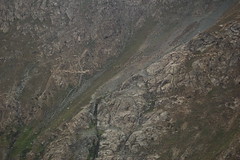 visible. From largely green mountain faces in Kullu and Lahaul, things change to barren mountain face post Lahaul, in Spiti and Kashmir.
visible. From largely green mountain faces in Kullu and Lahaul, things change to barren mountain face post Lahaul, in Spiti and Kashmir.The are patches of terrace farming & shepherds leading their sheep along the mountains for grazing.
Erosion
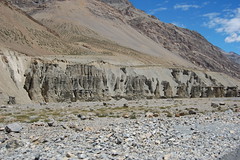
By the time we reached Taglangla (~5000m above sea level), the winding mountains, the heat and dust had already given me a severe headache. We stopped to get medical help at an army camp setup specifically to help civilans.
Other ways of getting to Leh:
- Do a 15 day cycle ride from Manali.
- Drive your own bike.
- Fly to Leh from Delhi.
- Take a 45 day walk to Leh.
Leh
Leh, is not as rustic as I expected it to be. It is no different from any other Indian town. It even boasts of a tennis court and golf course.
The Trek
 The first day of the trek starts at Spituk. It follows a jeep train from Spituk to Jianchen. The interesting thing is that the trek begins by crossing a the river Indus. Lots of trekking groups are around in Leh. Almost all are from European nations (French, Dutch, Spaniards, Italians).
The first day of the trek starts at Spituk. It follows a jeep train from Spituk to Jianchen. The interesting thing is that the trek begins by crossing a the river Indus. Lots of trekking groups are around in Leh. Almost all are from European nations (French, Dutch, Spaniards, Italians).The camp at Jianchan is along a tributary of the Indus. The camp sites are owned by locals. There are small patches of cultivated land where wheat or jowar is grown. The rent at the camp site is Rs 100 per day per tent.
We were accompanied by 3 folks, cook Passang Bhutia from Sikkim, guide Ghulam Qadir (from Nubra Valley, Ladakh) and pony man Sonawangdeo.
The second day of the trek would take us from Jianchen to Gandala base. Gandala base is ~4500 m above sea level. And the pass itself is another 400m higher and after a steep climb. It was a particularly nasty day for trekking. It was bright and sunny initially, but the moment a cloud covers the sun, the temperature drops. One can sense it the heat-to-chill change clearly. Not that such a thing is uncommon at high altitudes. I had experienced this during the Saurkundi pass trek. But added to that was the intermittent rain.
The climb didn't seem tough till Rhumbak village.
House at Rhumbak
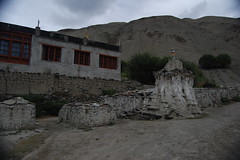
But from Rhumbak (3700m) to Gandala base (4500 m)is one tough climb. On the way we pass a 1 house village Urutse.
House at Urutse

The interesting thing about this section is the colour of the mountains we walk on. from white, to grey, to blue, to purple, it is one mindblowing experience. Not for the chromatically challenged ;).
Gandala base has 2 camping sites. Our tents were setup on the higher one. I was already drained and I don't know what energy reserve my body tapped into, to climb the rest of the way to the tent.
Each camping site has a restaurant run by the locals. It is a large tent where one can buy soft drinks, tea, fruit juices, omelettes, noodles, biscuits etc. There are no tent stays like the ones on the way to Leh. Tentstays allow people to stay overnight and provide mattresses and blankets.
Gandala base
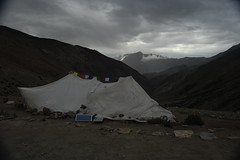
Solar panels find a lot of use along the way to Ladakh and in interior regions where electricity cables cannot be laid.
Another construction to note is Ladakhi toilets. These are composting pits. After use, one has to dump a shovel full of mud into the hole. Over time, the decomposition leads to manure which gets used as a fertilizer.
Reaching Gandala base gave me severe altitude sickness, so I had to return. The main cause being the lack of aclimatization in Ladakh.
Returning from Leh to Manali was eventless, till we reached around Gulaba, a small village 20Km from Manali. A mudslide had blocked the road and bull dozers would not come till the next day. So a large number of people in cabs, jeeps, trucks had to spend the night in their vehicles. So I was in the Qualis for 32 hours straight, spending 2 nights in it. That was some event!! :)
On the return from Manali I saw a most beautiful sight. A layer of mist over the Beas for quite some distance. Unfortunately, the camera was in the luggage hold, so couldn't take a snap.